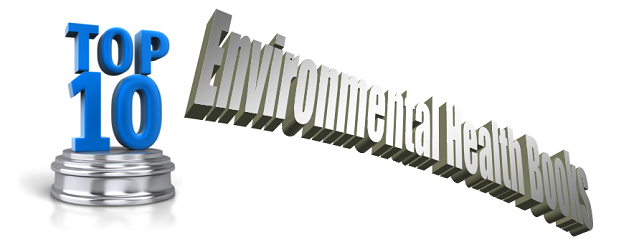We have compiled a list of the 10 most popular environmental health books. This list is based on an analysis of purchases and clicks through to the Amazon store.
1. Statutory Nuisance: Law and Practice
Statutory Nuisance: Law and Practice offers a comprehensive resource for practitioners in the legal and environmental health professions, guiding the reader through the complex practical and legal issues associated with statutory nuisance. It focuses on the problems that local authorities face in enforcing this area, as well as the issues facing those advising defendants. This title examines the role, powers, and duties of the local authorities, and the problems associated with drafting abatement notices and with the prosecution of nuisances. It also covers defences and proceedings brought by private individuals against neighbours and local authority landlords.
The book analyses what happens in court, considering in detail the procedure and requirements in appeals against notices and in prosecutions, as well as the grounds for bringing further appeals and judicial review. It covers important recent decisions and key legislation.
This new edition provides an update on the various types of statutory nuisance, additional chapters on new forms of statutory nuisance, and expanded material on adjacent areas of enforcement to statutory nuisance, notably those arising from the Anti-Social Behaviour agenda.
2. Environmental Health Procedures (Clay’s Library of Health and the Environment)
This is an essential reference source, providing an accessible entry into enforcement procedures for the complex body of UK environmental health law. The main legal procedures used in the environmental health field are presented as flow charts supported by explanatory text.
All chapters are updated to reflect new legislation and statutory guidance including:
- food safety – details of the new procedures now in place following both EC and UK legislation implemented in 2006
- housing standards – new standards and processes for securing acceptable housing following the radical changes brought by the Housing Act 2004
- Clean Neighbourhoods and Environment Act 2005
- Licensing Act 2003.
Covering all you need to know, environmental health officers and students will find this essential reading. It will also be a valuable reference for everyone whose responsibilities demand they keep abreast of current environmental health practices.
3. Clay’s Handbook of Environmental Health
Clay’s Handbook of Environmental Health, since its first publication in 1933, has provided a definitive guide for the environmental health practitioner or reference for the consultant or student. This twentieth edition continues as a first point of reference, reviewing the core principles, techniques and competencies, and then outlining the specialist subjects. It has been refocused on the current curriculum of the UK’s Chartered Institute of Environmental Health but should also readily suit the generalist or specialist working outside the UK.
4. Risk-Led Safety: Evidence-driven Management
Modern day managers and health & safety professionals are bombarded with advice and pressure from every angle. Phone calls from companies trying to sell services or training and implying that without their help managers could face imprisonment. There are national and international standards that imply that they can provide a suit of armour to fend off enforcement and litigation. There is industry and HSE guidelines that are often mistakenly viewed as prescriptive requirement. Oh – and don’t forget the persecution in the press! You can’t even go to a bar these days without someone expressing a view on what should be done. All this advice confuses people and can shake their beliefs. Risk-led Safety, Evidence-driven Management is a book that is a beacon in this storm of opinion. It strips the law back to its basic elements and focuses on its spirit and intent. It dismisses needlessly complicated ideology to reveal what perhaps Lord Robens really had in mind. So if you want a book that uses plain and simple language to explain what the law is really asking you to do, then this is the book for you. In it you will learn fresh ideas that will enable you to: – use the arguments of reasonableness more effectively. – identify precisely which risk assessments you need and those you don’t. – avoid common mistakes when risk assessing. – develop a risk management system through defining which risks are the most significant. – develop a pragmatic approach to risk control. – engage employees, managers and the Board and encourage them all to be responsive. – implement any necessary changes into the workplace. The authors have over 45 years of experience between them. They have applied and developed these ideas in many different organisations and industries. This is a no nonsense book by health & safety practitioners who have learnt their craft from doing it.
5. Inspections and Reports on Dwellings: Inspecting (The Inspections and Reports on Dwellings)
With the introduction of Home Information Packs and Home Condition Reports house buying is being revolutionised!
This second book in the series of four, following Inspections and Reports on Dwellings: Assessing Age, covers the entire field of inspecting dwellings, from ascertaining the clients’ requirements, setting the instructions by way of agreeing the Conditions of Engagement for any one of the five types of report envisaged as being covered by the series, to the physical inspection itself. Desirable attributes in the surveyor are discussed – qualifications, necessary insurance cover, both in respect of liability for his work and his own person, together with his fees.
Court cases determining the scope and level of inspection are given full consideration and there is a concentration on ascertaining, particularly in regard to age, the materials and forms of construction that make up each part of a dwelling, the structure, finishes, services and surroundings and its condition, all by means of sight, sound, feel and smell.
- Contains 350 colour photographs
- Relates defects to age and all types of construction
- Second in the series of four
6. The Damp House: A Guide to the Causes and Treatment of Dampness
Dampness can become an enemy when it invades our interior space, when it persists, when it spreads and damages our domestic fittings, finishes and furnishings, when it encourages the growth of moulds that threaten our health, and when it stimulates the spread of fungus and decay in the structure of our houses. A major industry has developed with specialist contractors but such contractors sometimes concentrate on a single treatment rather than offering a comprehensive diagnosis.
7. Master Handbook of Acoustics
Build your own acoustic environments such as recording studios, control rooms, and home listening rooms with expert insights from two engineering professionals. Fully expanded to cover the latest methods and software tools, Master Handbook of Acoustics, Fifth Edition presents clear explanations of acoustic phenomena and provides a hands-on approach to room design. Learn how to perform acoustic measurements, choose room dimensions, assign speaker placement, analyze response curves, and design and install sound absorbers and diffusers. You will also find details on how to fine-tune room reverberation, minimize external noise, and apply psychoacoustic concepts.
Master Handbook of Acoustics, Fifth Edition explains how to:
-
Determine how sound propagates in open and enclosed spaces
-
Measure sound-pressure levels and work with decibels
-
Analyze the characteristics of room modal resonances
-
Treat rooms for optimal early reflections, reverberation, and diffusion
-
Minimize acoustic distortion, comb-filter effects, and HVAC interference
-
Construct high-quality stereo and surround-sound listening rooms
-
Design personal and professional recording studios and control rooms
-
Understand the acoustics of auditoriums and concert halls
-
Optimize room designs using measurement, modeling, and auralization software
8. HACCP Made Easy
HACCP is seen by many people as a mysterious, complicated and difficult concept. But this does not have to be the case. This book introduces and explains the 12 steps to HACCP in a clear and accessible way, using everyday examples from cooking a chicken to playing a game of football. It demonstrates how HACCP is applied in practice, with practical scenarios, case studies and completed HACCP control charts, supported by interactive questions and answers. It provides a firm foundation of HACCP understanding for readers of all backgrounds.
9. Environmental Law
Environmental Law addresses a wide range of topics, introducing students to all of the key areas and latest developments of environmental law, drawing on legislation, policy, and practice. The seventh edition features a new chapter on the law relating to air pollution and climate change, as well as more detailed coverage of environmental liability at national, EU, international, and transnational levels. Reference is made throughout to the influence of European and international organisations and legislation and offers enhanced introductory coverage of global dimensions. Topics are fully cross-referenced, allowing readers to follow key ideas through the book and to understand the interaction of law and the environment. The book is structured by theme and by sector and presented in a clear colour design, guiding the student through the subject. Online Resource Centre An Online Resource Centre featuring updates to the law, latest developments, and web links, accompanies the book.
10. Text and Materials on Housing Law
Hughes, Davis, Matthew and Jones: Text and Materials on Housing Law is a collection of housing case law and legislation combined with commentary to enable students to fully understand the often complicated language of the law. It gathers together all the important original materials to which students of housing law will need to have access.






